Brief

Auf einen Blick
- The Greater Bay Area (GBA) is poised to become a technology, innovation, and e-commerce hub for small and medium enterprises (SMEs). SMEs are optimistic about the GBA’s economic potential and government policies to promote interconnectedness.
- SMEs need loans to meet their domestic funding needs, but they struggle with the application process. Innovations, such as using alternative data in credit assessments, can help alleviate pain points.
- Financial institutions can fuel the area’s growth by making it easier for SMEs to buy and use cross-boundary financial products. Smoother processes, digitization, and better information flows will benefit SMEs.
- Financial institutions that want to expand in the GBA must define their long-term vision for the region and determine where to play and how to win.
The Greater Bay Area has a strong platform for growth
The Guangdong-Hong Kong-Macao Greater Bay Area (GBA) comprises the two Special Administrative Regions of Hong Kong and Macau and nine cities in Guangdong Province. As of 2021, the region has 87 million permanent residents and significant economic potential.
Written in collaboration with
Written in collaboration with

In 2021, the region’s gross domestic product (GDP) was approximately US$1.9 trillion (see Figure 1). That makes the GBA one of the world’s biggest economies, similar in size to that of Canada or South Korea.
And the region is growing quickly. Over the past decade, year-over-year GDP growth has been around 7%, despite some cooling from the Covid-19 pandemic. Based on Bain & Company’s analysis of forecast data, the GBA’s GDP could hit US$2.8 trillion by 2027.
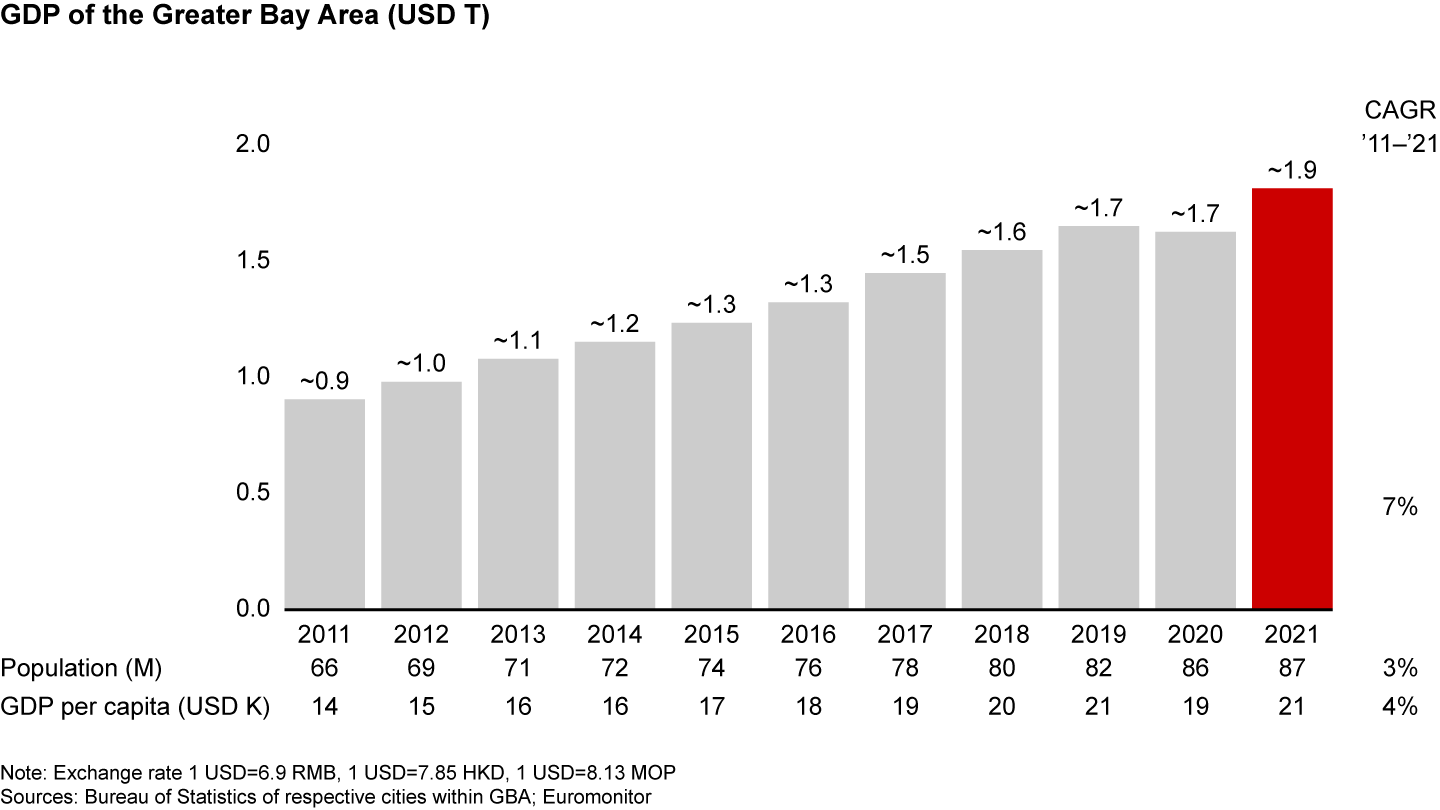
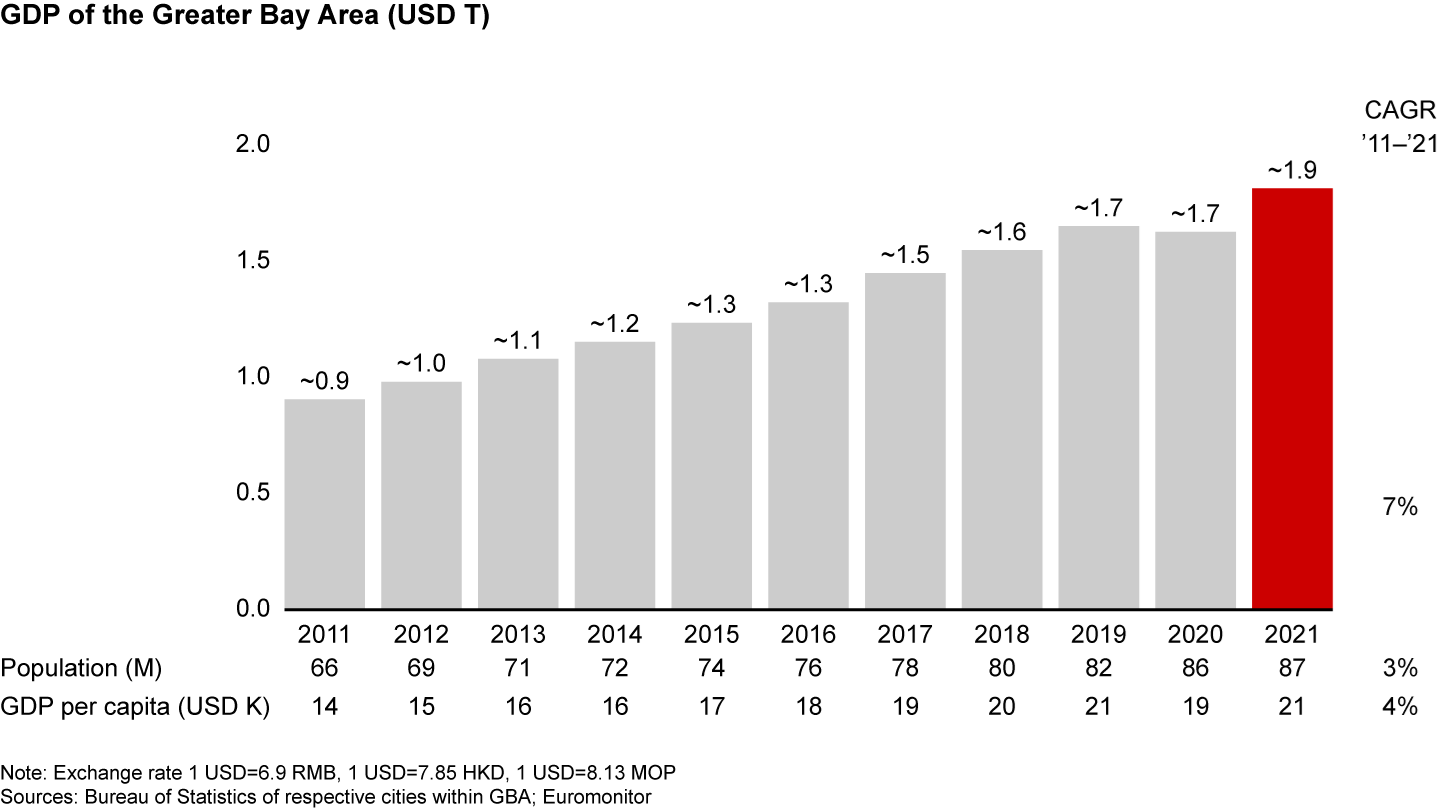
Small and medium enterprises (SMEs) are a major driving force of economic activity in the GBA. Nine mainland cities within the GBA are home to around 2.5 million microenterprises, 270,000 small-sized enterprises, and 27,000 medium-sized enterprises. SMEs in Guangdong Province accounted for 55% of the province’s GDP in 2021.
Additionally, there is a high concentration of large corporations in the GBA that benefit from a sizeable ecosystem of SMEs as partners, suppliers, and manufacturers. Large corporations, in return, provide sustainable revenue streams for SMEs and give them access to new customers, partners, and suppliers.
Over the past two years, the Guangdong, Hong Kong, and Macau governments have launched policies to promote interconnectivity within the region. These governments aim to develop the GBA into a world-class technology, innovation, and e-commerce hub by connecting the region’s talent, research-and-development infrastructure, and financial resources.
For example, tax policies, settlement incentives, and rent subsidies are available to companies in key industries (such as high-tech manufacturing) to promote development and help them attract high-quality talent. In November 2022, the Qianhai Authority unveiled the Qianhai Global Service Providers program. This will provide funding and office space to attract a cluster of service providers in industries such as business logistics, information services, and finance. In Nansha, the State Council unveiled plans to establish preferential tax policies for enterprises in encouraged industries that register in the district. And in Hong Kong, the Chief Executive’s 2022 policy address pushed for the development of an innovation and technology hub in the Northern Metropolis, and for building connectivity and synergies with a technology cluster in Shenzhen.
Policies that promote connectivity and development within the GBA will be important for businesses operating on both sides of the border. For SMEs in Hong Kong and Macau, stronger connections between the regions will provide greater access to customers and business opportunities in mainland China. Mainland China can use the GBA to “test the waters” of a more open financial services system, leveraging Hong Kong’s financial services infrastructure and experience as a global financial services hub to bring more financial services opportunities to the GBA and to China overall.
SMEs have strong expectations for the GBA’s economic potential and plan to invest in the region
To measure the current economic sentiment, Bain & Company surveyed leaders from more than 460 SMEs in the GBA. Our survey addressed SMEs’ financial services needs and preferences in the short term (through 2025) and longer term (2025–2035).
The pandemic and geopolitical tensions dampened short-term prospects for the GBA. About half of the mainland SMEs and a third of the Hong Kong SMEs believe the GBA’s short-term growth rate will be slower than their pre-pandemic expectations. Some sectors, such as technology and software development, were less affected, and their short-term expectations in the GBA have remained strong.
Overall, SMEs are confident about the longer-term prospects. Over two-thirds of Hong Kong and mainland SMEs expect long-term economic growth to be similar to or stronger than the region’s historical growth (see Figure 2). The majority of SMEs (70%) are optimistic and enthusiastic about the government’s interconnectedness programs. About 80% of SMEs would like the government’s initiatives to be implemented faster (see Figure 3).
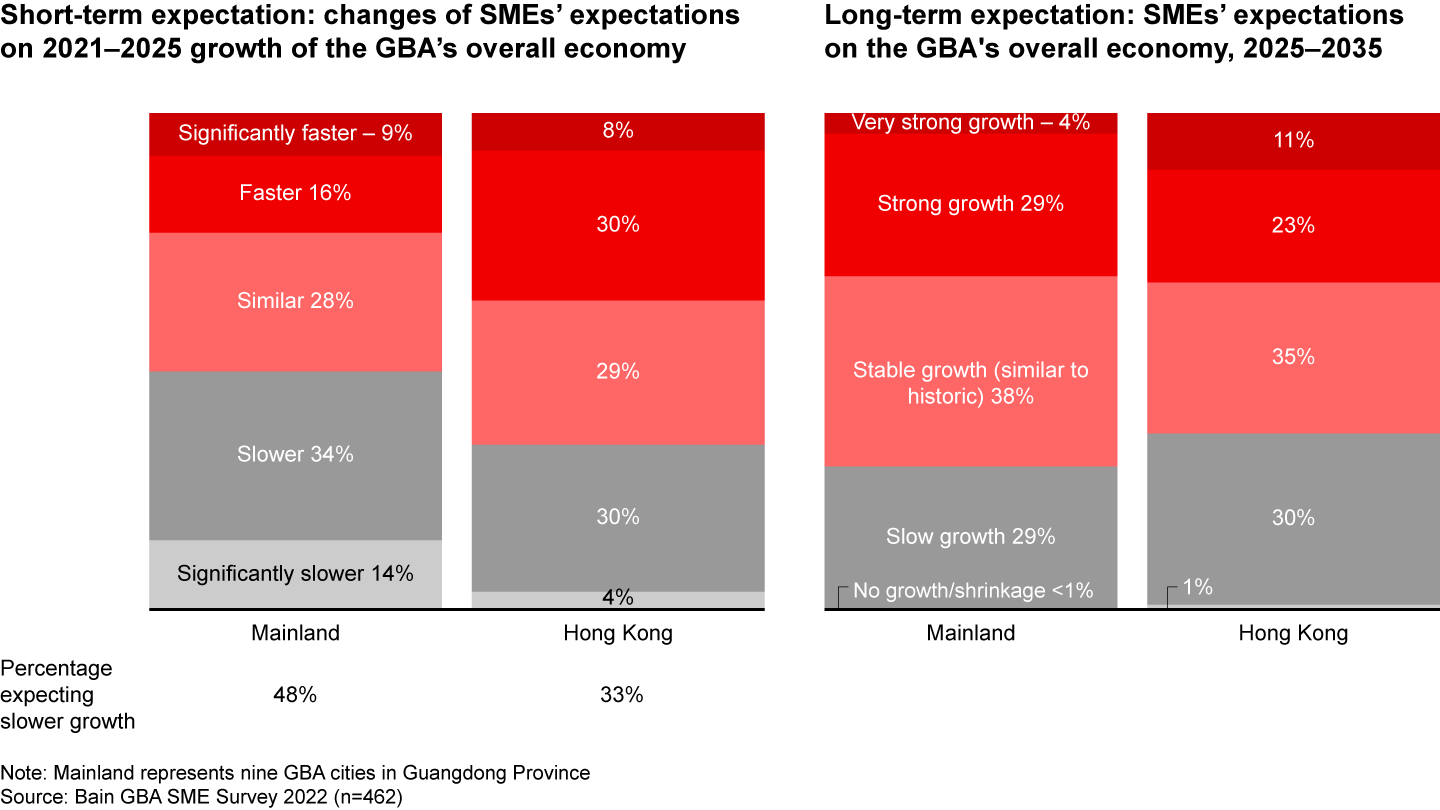
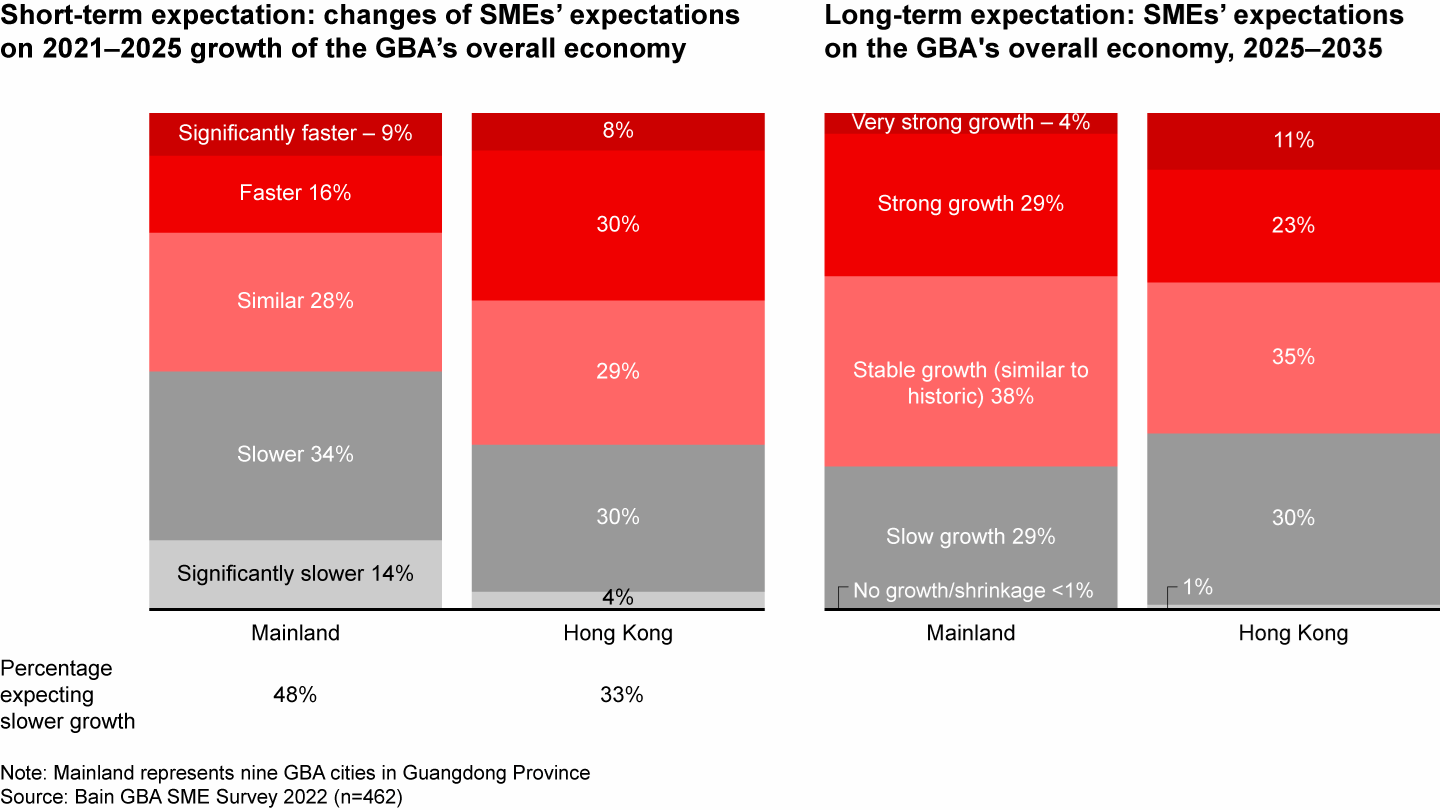
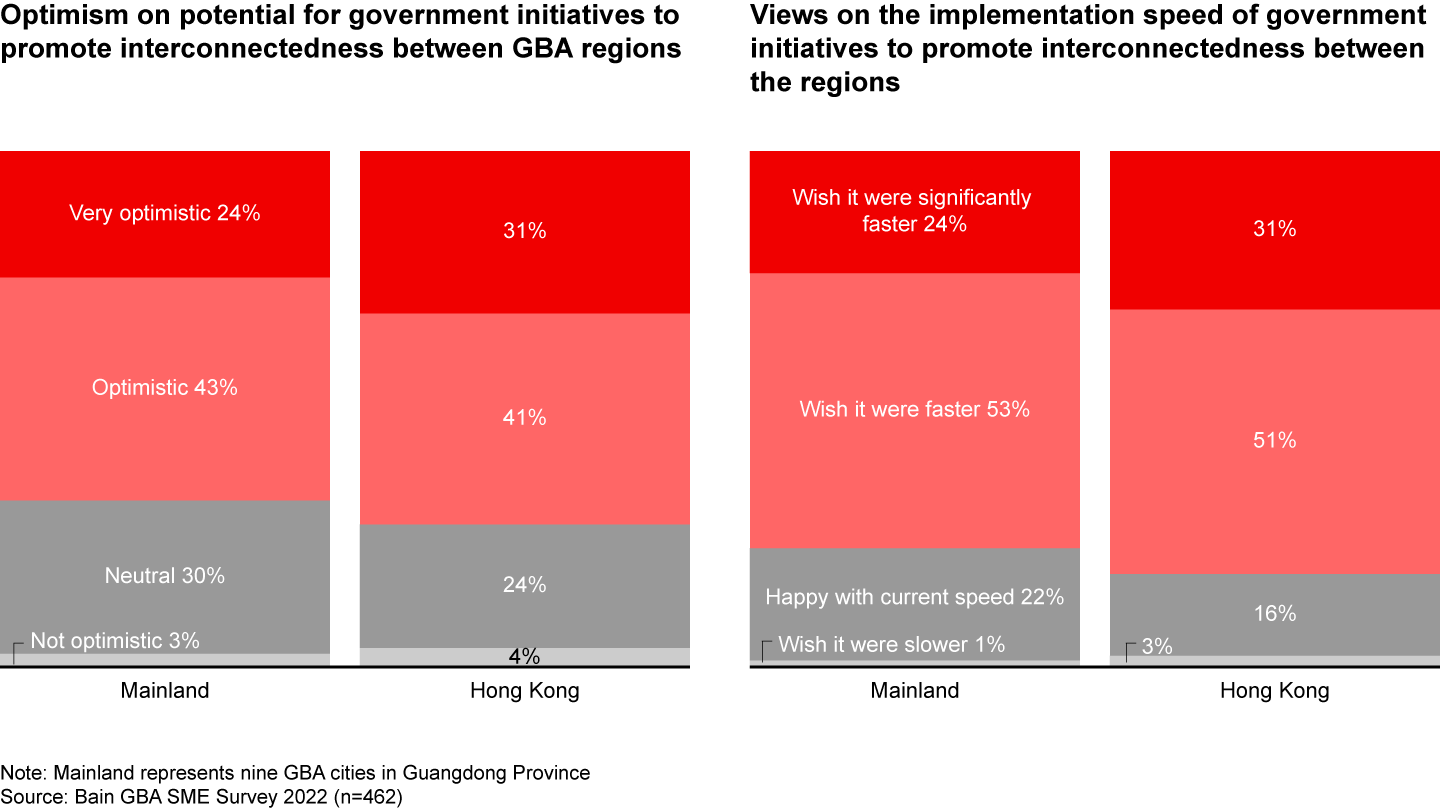

More cause for optimism: SMEs are ready to invest in the region. About 80% of mainland SMEs and 60% of Hong Kong SMEs expect to invest 15% or more of their revenues in the next year (see Figure 4). In comparison, on average, listed Chinese companies invested 6% of their revenues in capital expenditures between 2017 and 2021. However, SMEs need help to expand. They need support from financial institutions in both mainland China and Hong Kong, tailored cross-boundary financial products, and convenient delivery models.
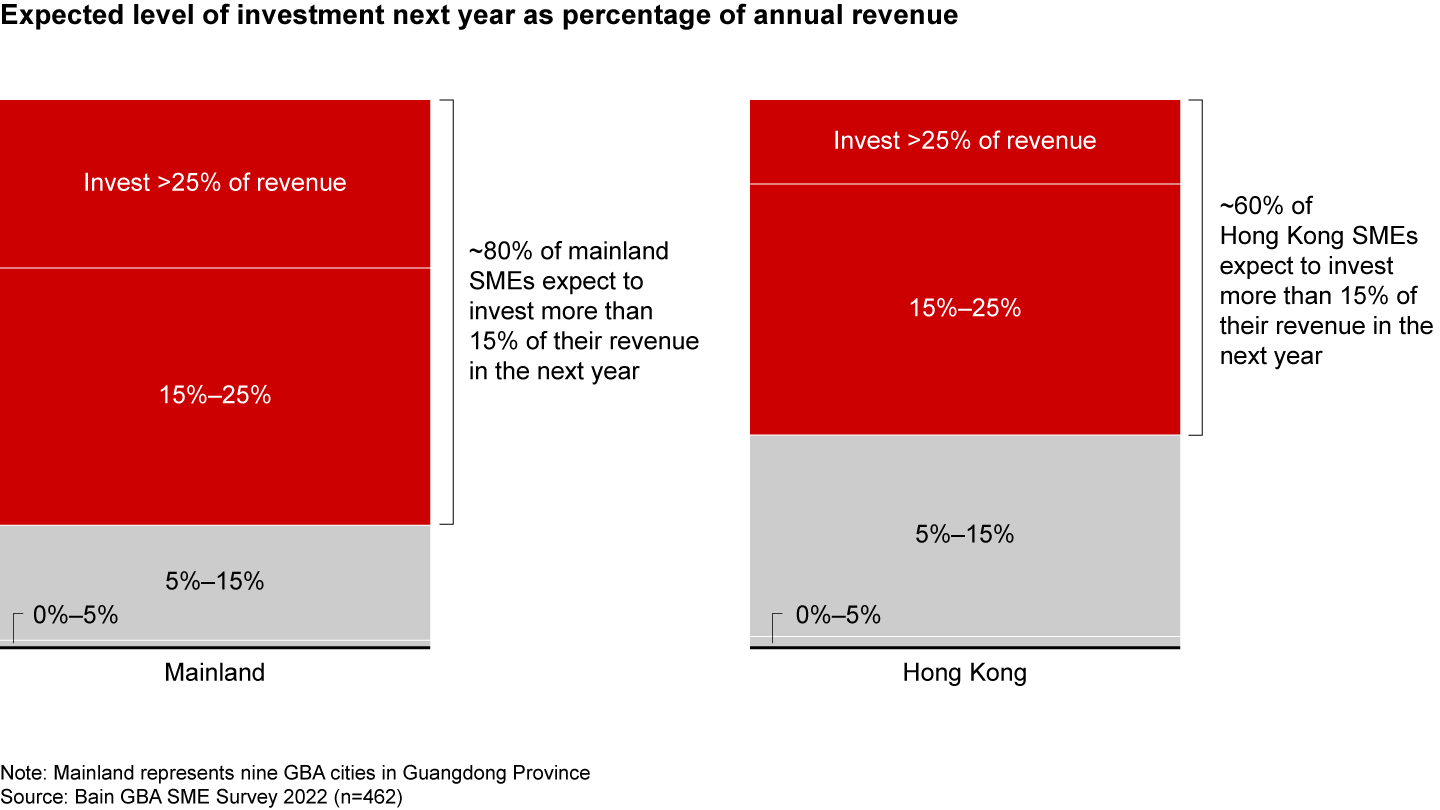
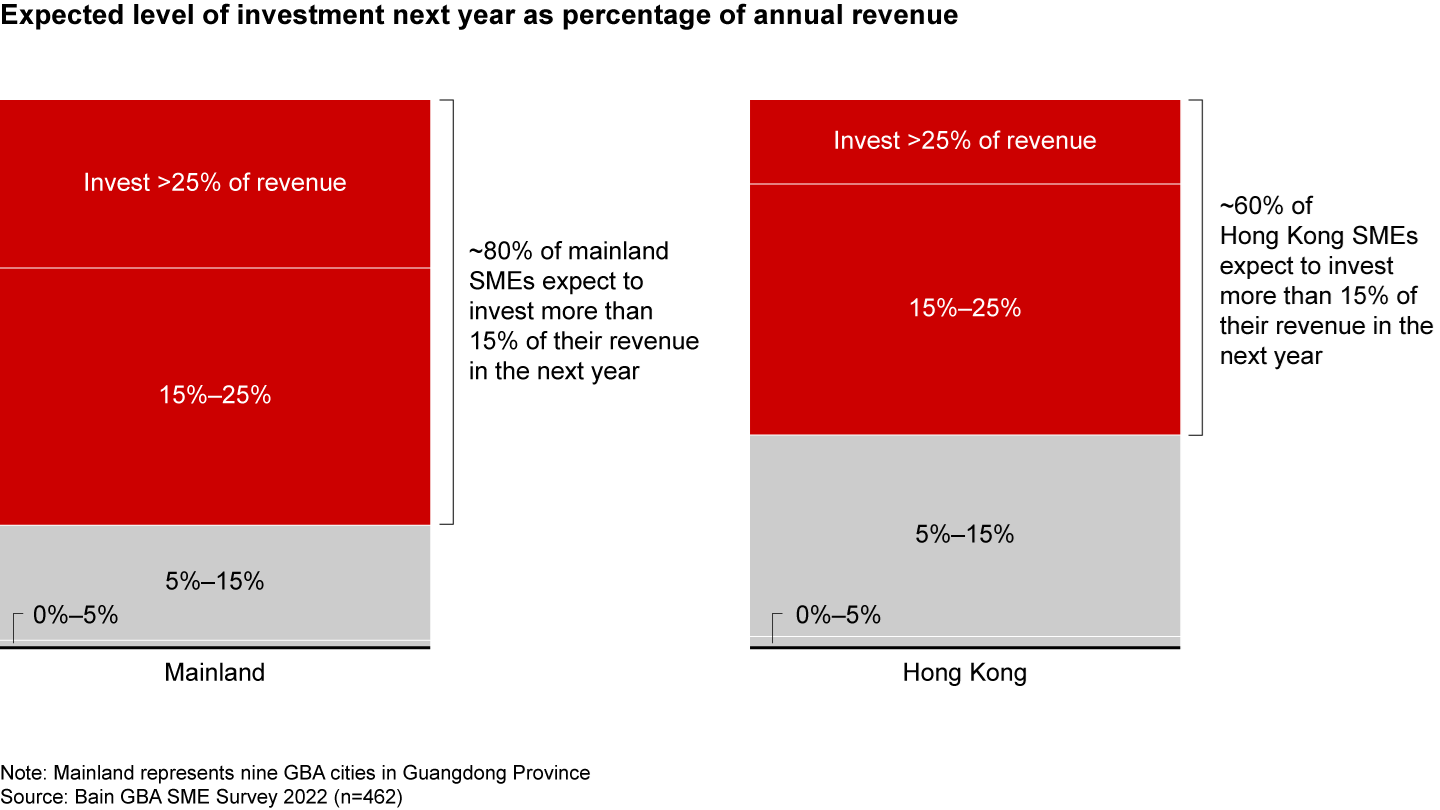
SME’s domestic financial needs can be better served through innovation
Domestic loans
Demand for funding is high, but many SMEs report being underbanked. In 2021, total corporate loan balances for mainland SMEs in the GBA amounted to around RMB 3.5 trillion (equivalent to US$500 billion). However, about 60% of mainland SMEs and 35% of Hong Kong SMEs still need to secure a significant amount—more than 40%—of the funds they need for domestic investments and operations in the next three years. Many SMEs raised concerns about their ability to secure loans within the GBA because they lack collateral or because the documentation requirements are too high.
Traditional credit assessments require SMEs to provide financial statements or management accounts or to put up significant collateral, like real estate. Such assets and documents are not readily available to most SMEs and would take significant effort to prepare.
Financial services providers can encourage cross-boundary lending and provide better service by helping SMEs navigate the requirements. Financial institutions can also focus their evaluations on key data and documents that are most critical for credit assessment.
There is also potential for financial institutions that find alternative ways to conduct credit assessments, secure guarantees, or offer more attractive unsecured loan products. “For SME lending in the GBA, there is potential to use alternative data, such as inventory levels or online customer feedback, to estimate demand for a company’s products,” suggests Wendy Ho, head of business banking at Hang Seng Bank.
Hang Seng Bank partners with QFPay HK, a mobile payments provider, to streamline the commercial lending process. The bank leverages the Hong Kong Monetary Authority’s data exchange platform, Commercial Data Interchange, to enable consented access and secured use of commercial data of merchants who use QFPay. Connecting to up-to-date merchant data helps Hang Seng Bank make lending decisions. It also speeds up the loan application process and gives customers faster access to financing.
Financial institutions in the region are also creating new mechanisms to provide capital and collect returns. Micro Connect, a financial market platform that launched in 2021, invests in small businesses across China and automatically collects a portion of their daily revenues. This collection method gives SMEs that struggle to secure financing from banks greater access to funding. Banks may be comfortable exploring similar models with existing customers since they have more visibility into and control over SMEs’ receivables.
“In a model similar to receivables financing, banks can explore offering loan products that are automatically repaid based on a customer’s incoming transactions,” explains Stephen To, head of digital and business transformation at Hang Seng Bank.
Domestic wealth management
There is also demand for other financial services products, like wealth management. However, SMEs’ preferences have shifted since Covid-19. The pandemic caused them to prioritize financial stability and cash flow over other factors, so now SMEs want wealth management products with more flexibility. For example, they want the ability to change or withdraw investments with low or no fees.
Who is meeting this demand? Mainland SMEs largely use local Chinese financial institutions for wealth management. On the other hand, Hong Kong SMEs readily use financial institutions from different regions, including Hong Kong, mainland China, and overseas.
Only a third of the mainland SMEs we surveyed have used a foreign institution’s wealth management product. SMEs say that the purchase threshold is higher for foreign providers and that they already have strong relationships with domestic providers (see Figure 5). Transparency, convenience, and fees also factored into the decision.
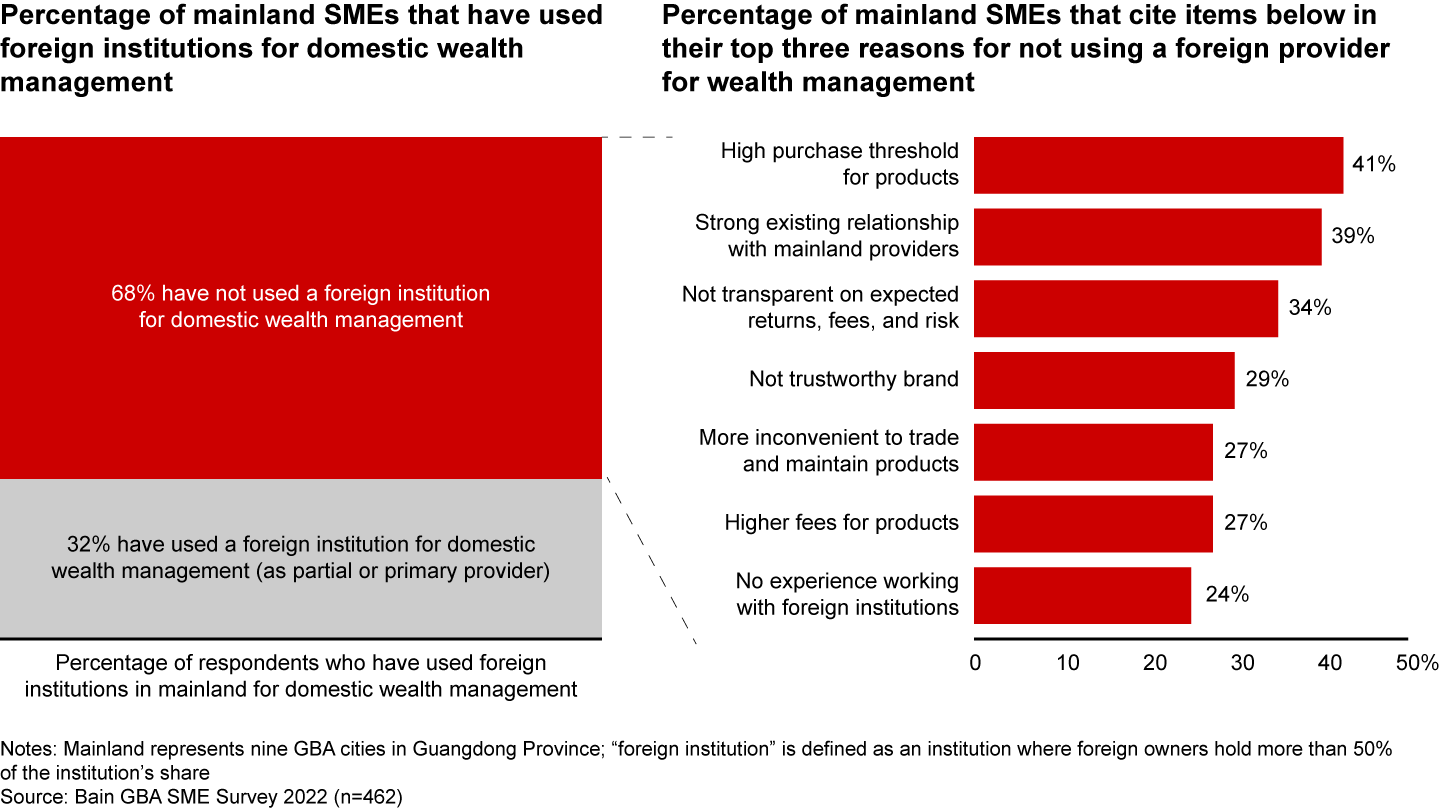
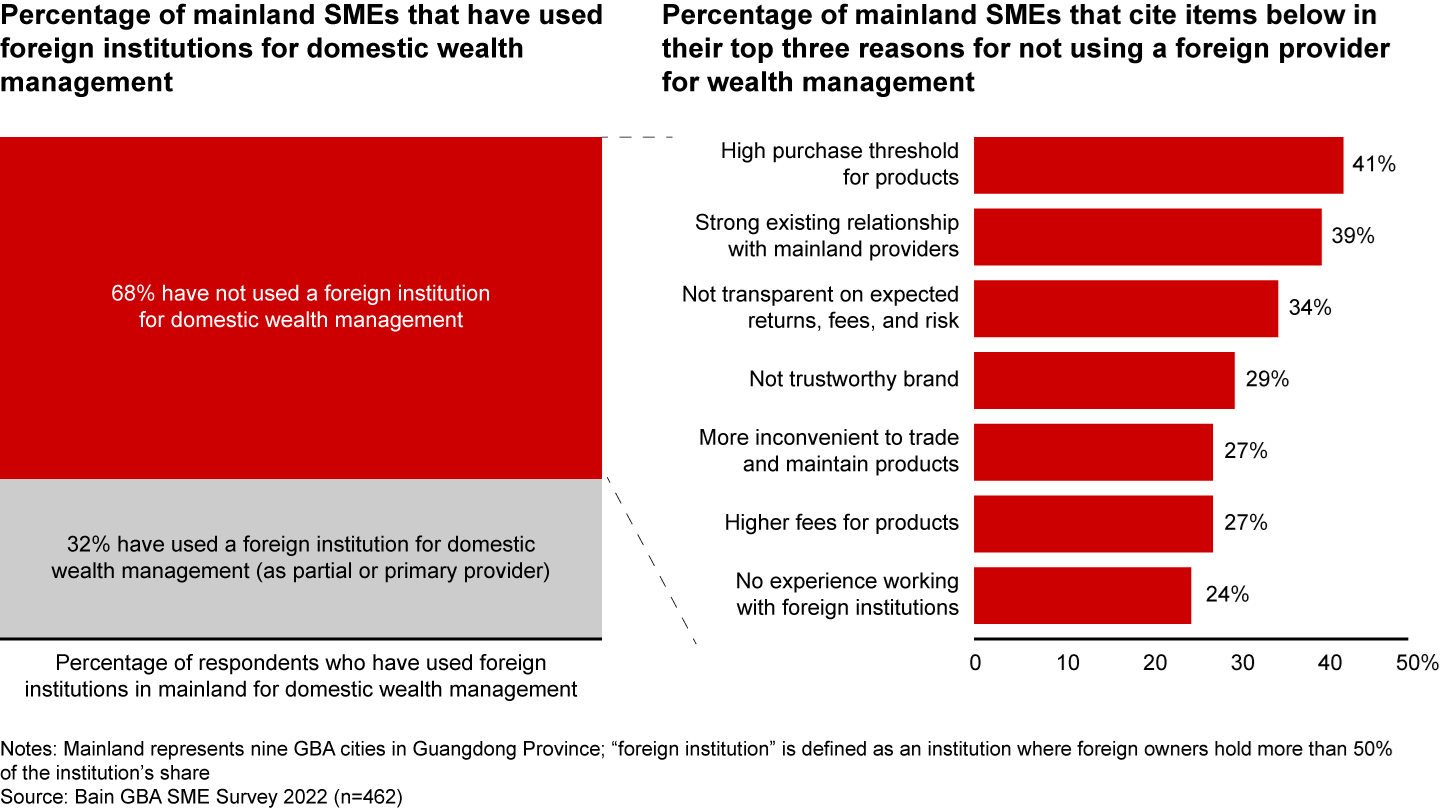
While local financial institutions have a strong advantage in the mainland China market, foreign financial institutions still have an opportunity to distinguish themselves through superior service. Mainland SMEs would consider foreign financial institutions that provide professional and tailored wealth management advice.
In contrast, the top mainland-based financial institutions already have a strong foothold and significant market share in Hong Kong. Over half of the Hong Kong SMEs we surveyed use mainland financial institutions for wealth management, citing more promising returns and competitive fees. Hong Kong SMEs that use domestic Hong Kong or non-Chinese providers cite good customer service as a primary driver.
Domestic channel preferences
Both mainland and Hong Kong SMEs prefer digital channels for their domestic financial services. About 55% of mainland SMEs and 60% of Hong Kong SMEs said digital was their most preferred channel (see Figure 6).
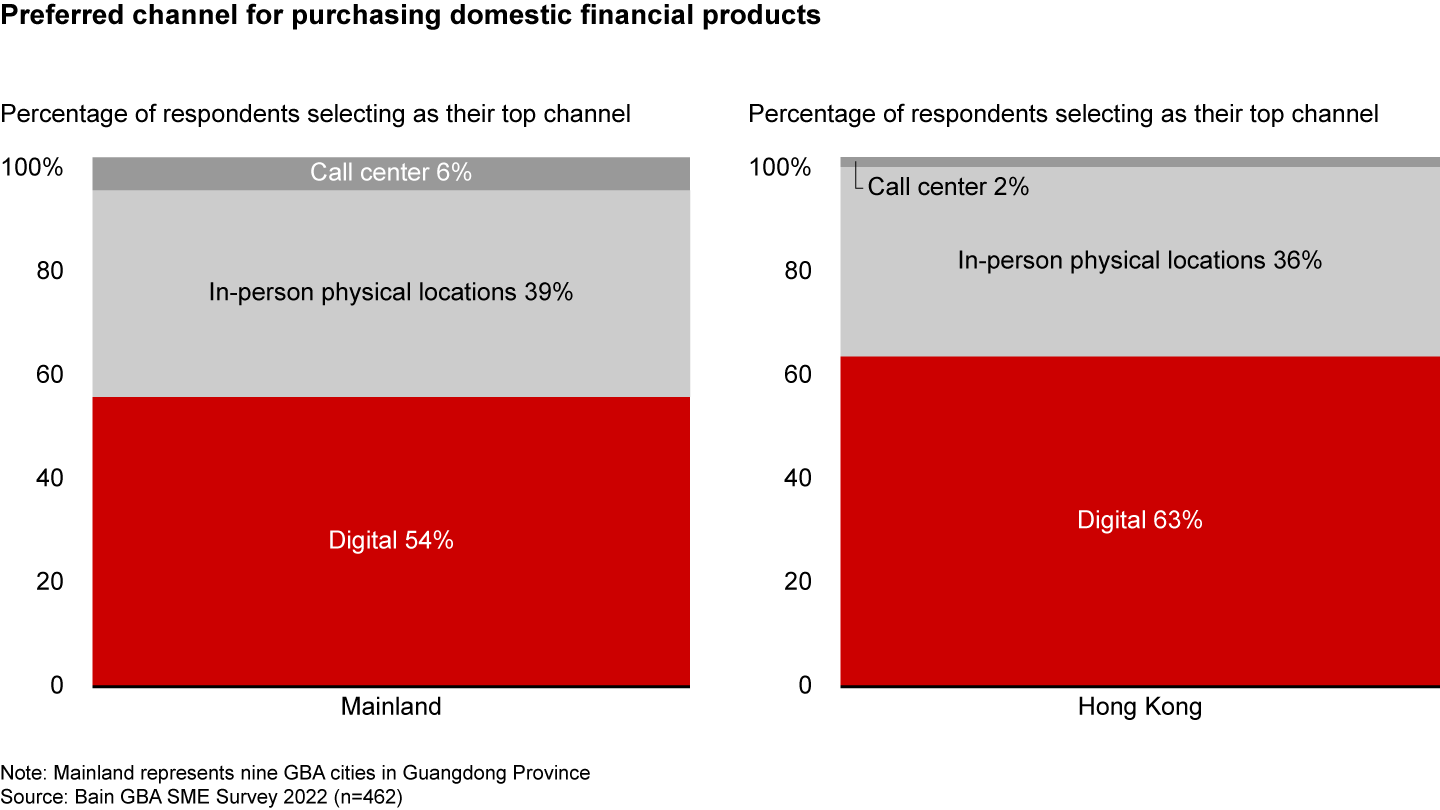
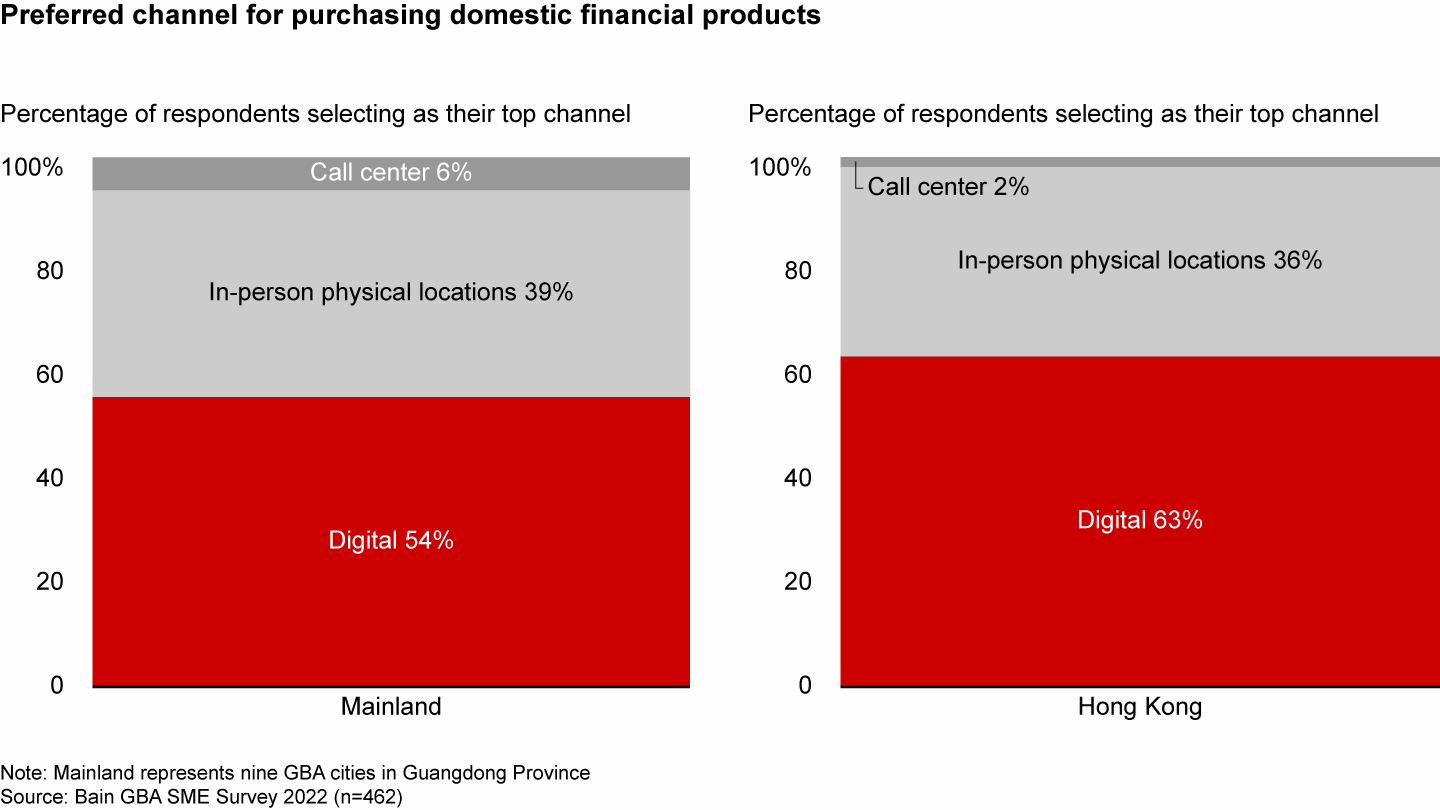
Demand for GBA expansion and cross-boundary financial products is strong among SMEs
Cross-boundary expansion for SMEs
Even with Covid-19-related travel restrictions, demand for cross-boundary expansion is high. About half of the mainland SMEs want to expand southward, while 75% of Hong Kong SMEs say they’re likely to expand within mainland GBA cities (see Figure 7). As restrictions ease, expansion plans could increase.
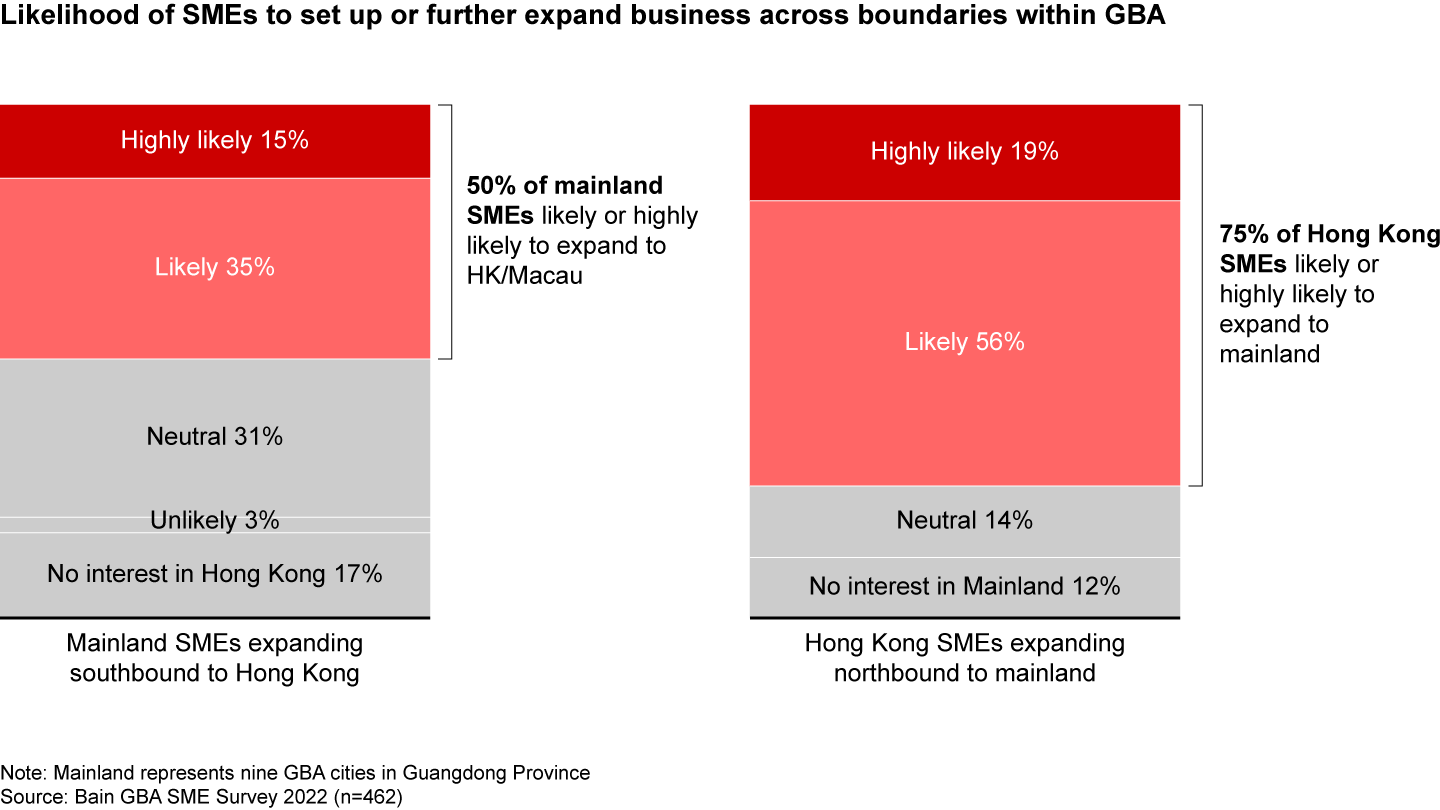
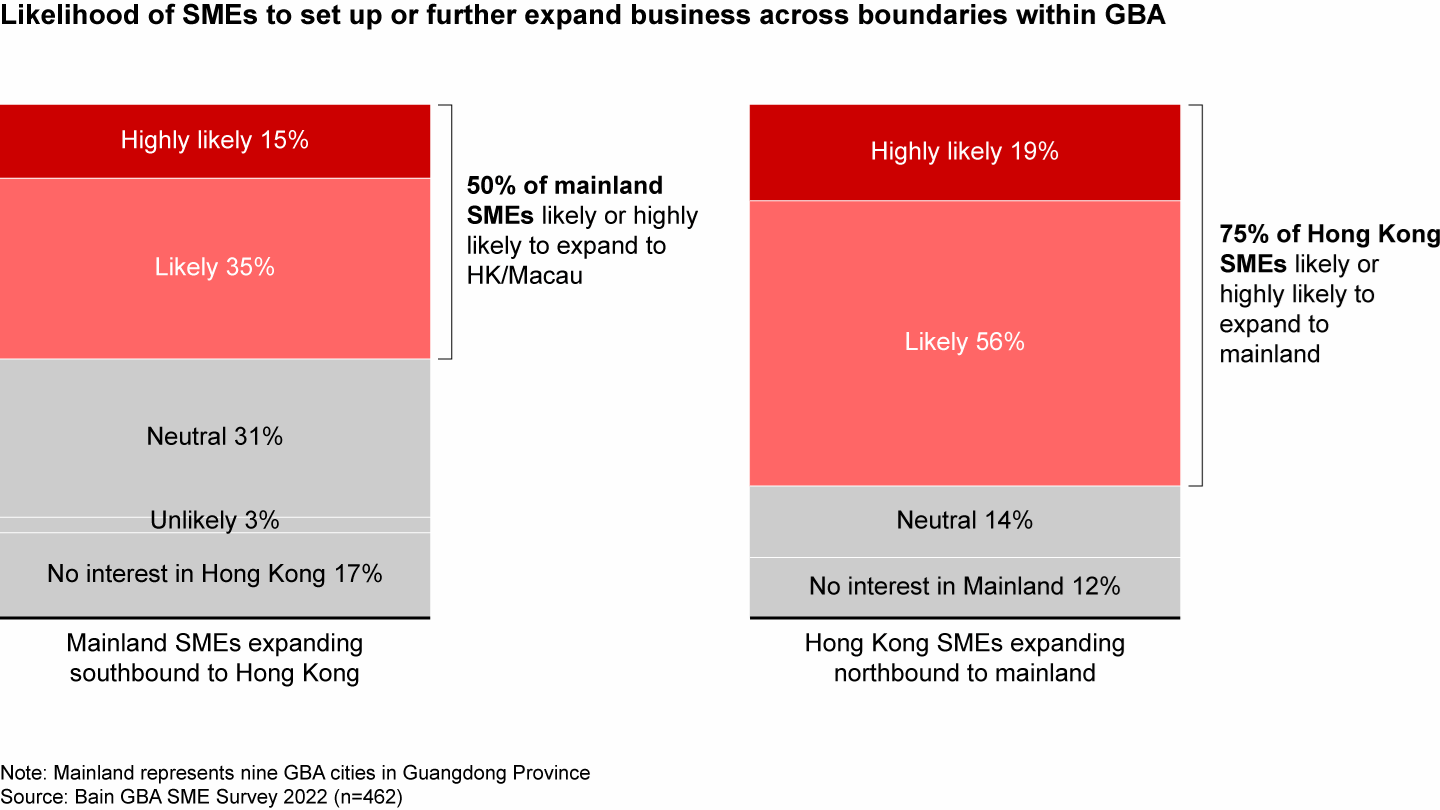
If financial institutions can simplify their cross-boundary processes, they are uniquely positioned to help SMEs expand. About 40% of SMEs say cash management and payments services are the most important financial products for cross-boundary expansion. Quick and convenient remittance is also important to customers. Financial institutions can help SMEs stay informed of the latest remittance policies and help them optimize cash management and remittance plans.
Value-added services from financial institutions can also help SMEs expand. For example, more than half of the SMEs we surveyed would like financial institutions to facilitate introductions to local partners, suppliers, and trade associations. They believe banks can offer more than just core financial services to accelerate cross-boundary expansion. Such services can strengthen a financial institution’s value proposition and distinguish it from peers.
Demand for cross-boundary financial products
Over a third of the mainland SMEs are interested in or already own insurance and loan products from Hong Kong, and nearly half (48%) are interested in or use wealth management services from Hong Kong (see Figure 8). Mainland SMEs say they’re attracted to Hong Kong’s wealth management products because they have better liquidity, easier access to foreign exchanges, and the potential to diversify risk.
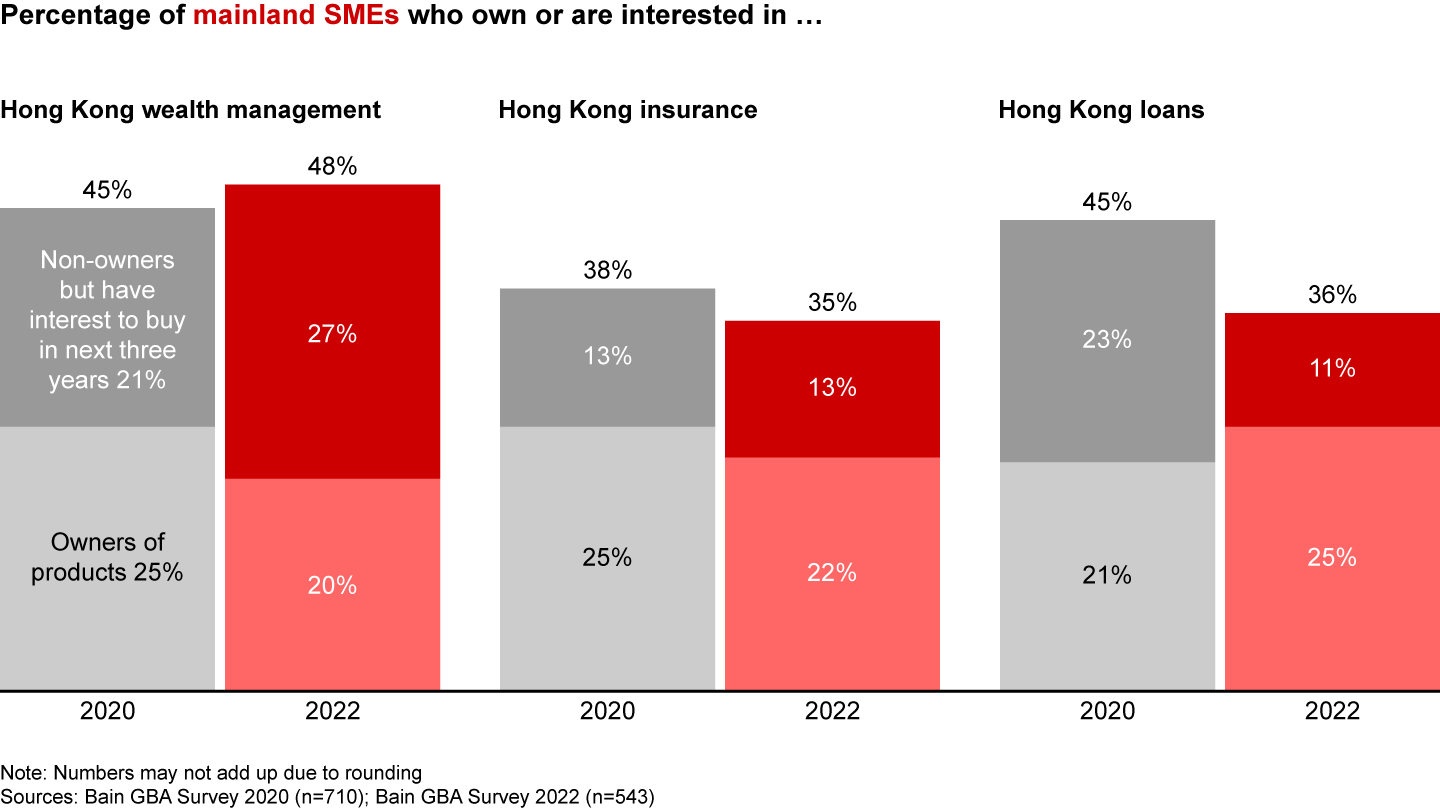
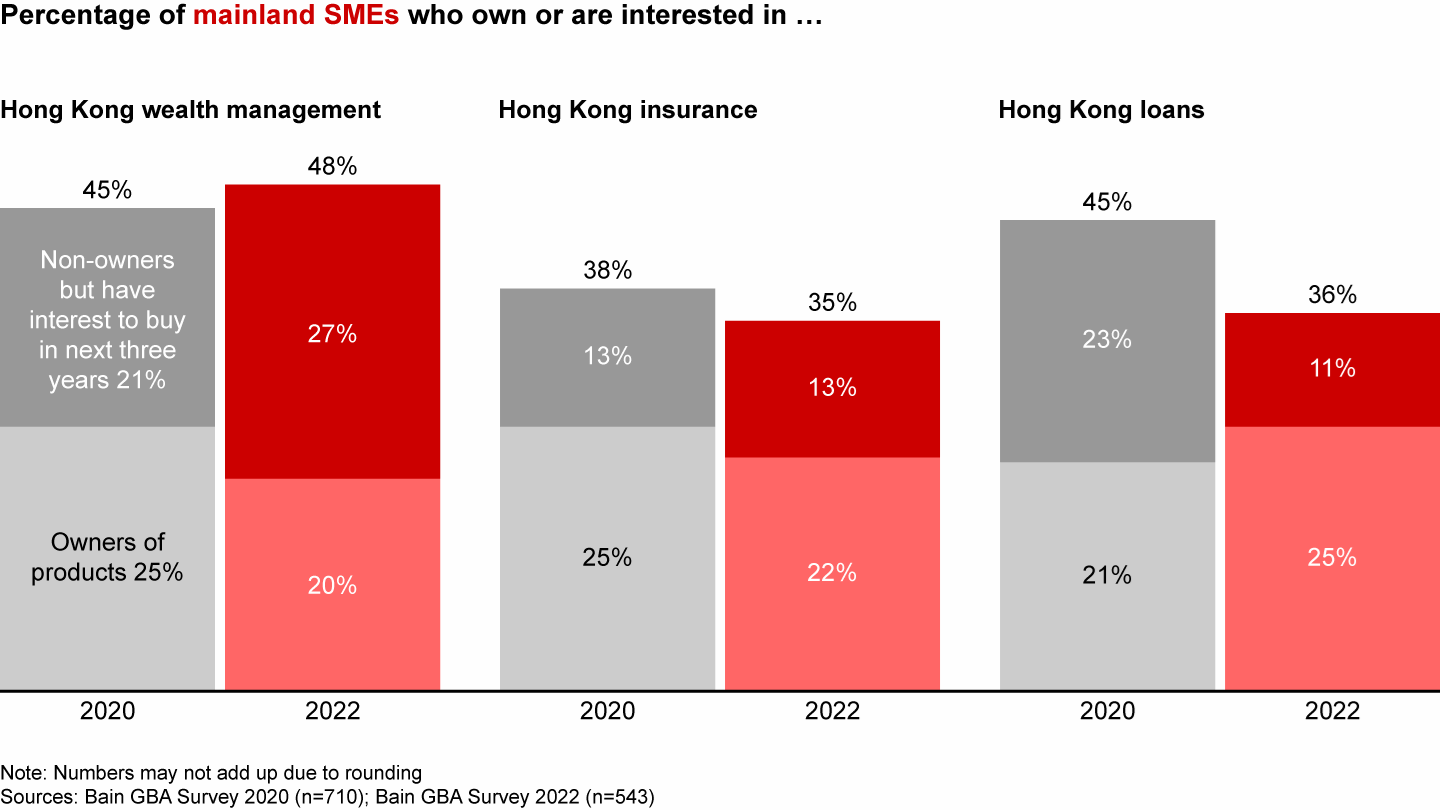
Based on our surveys, ownership of cross-boundary wealth products has decreased since 2020. The decrease is most likely linked to poor performance in the financial markets.
Northbound interest is similar. Over a third of the Hong Kong SMEs are interested in or already own insurance, loans, and wealth management products from the mainland (see Figure 9). In Hong Kong, SMEs want cross-boundary products to satisfy business needs, like health and life insurance for employees in the mainland.
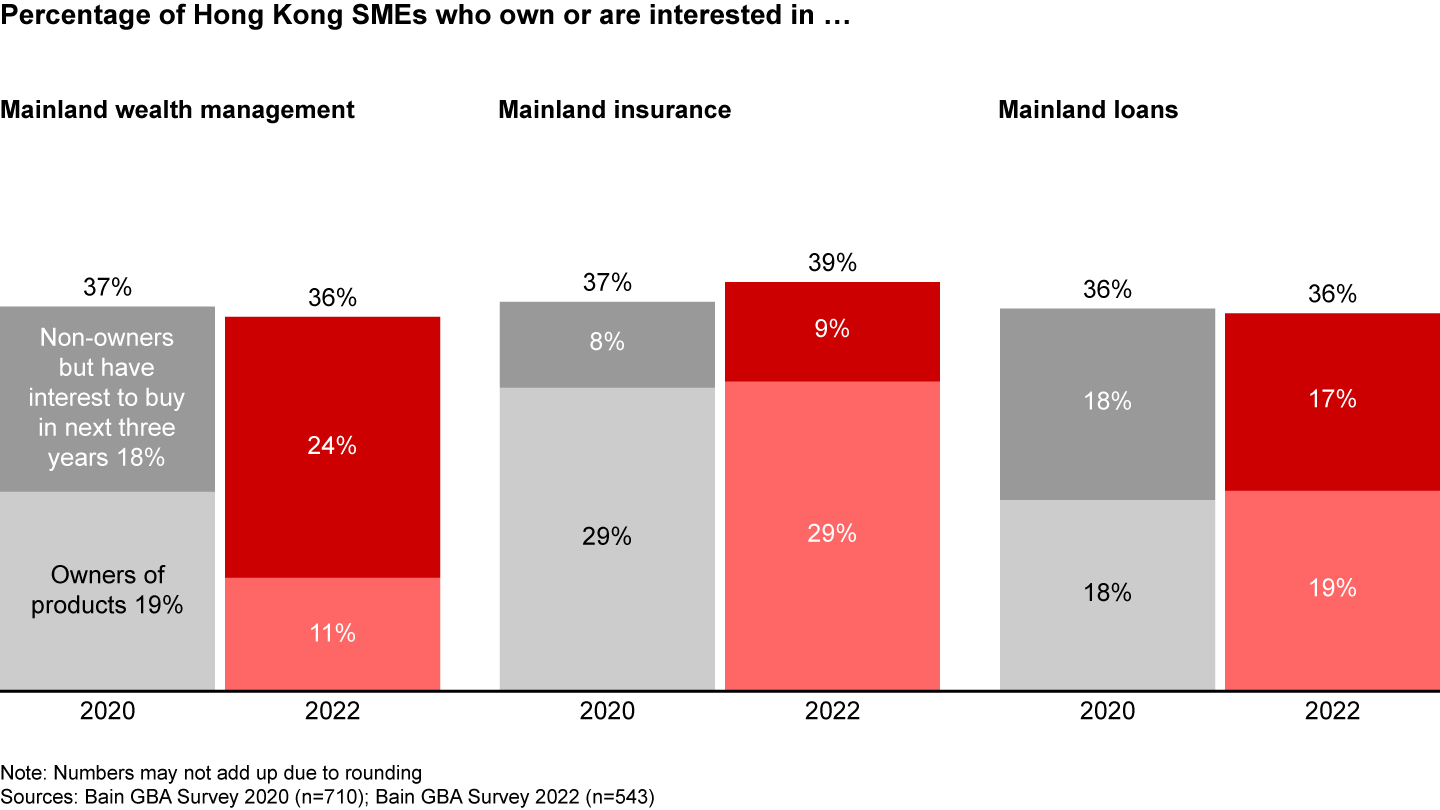
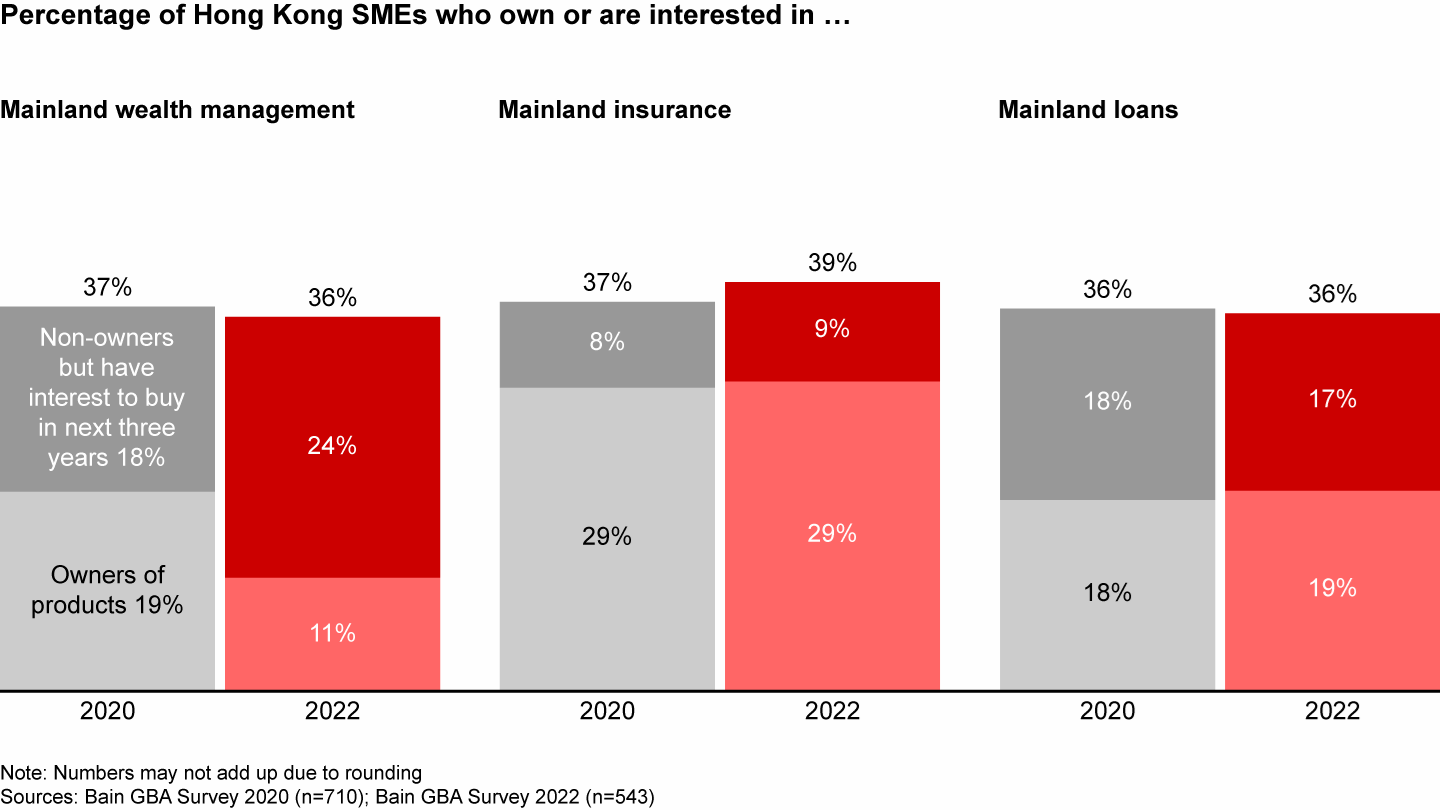
Cross-boundary insurance
Demand for cross-boundary insurance is strong, but SMEs experience several pain points when buying and using cross-boundary products. SMEs say products are difficult to understand and inconvenient to purchase and use.
About a third of the SMEs in both mainland China and Hong Kong say they don’t consider foreign insurers because they don’t understand the products. With border restrictions in place, it’s difficult for customers to learn about the products in detail, as they cannot visit insurance agents in person. Instead, mainland SMEs have to rely on providers’ websites, where product information is too simplistic or vague to hold their interest or inform decision making. It’s also hard to compare products offered by different institutions. Online aggregator platforms (created by providers or an independent third party) could help financial services companies clear this obstacle for SMEs.
Inconvenience is another major barrier cited by SMEs on both sides (see Figure 10). Sixty-five percent of Hong Kong SMEs and nearly half of the mainland SMEs say buying and using cross-boundary products is too cumbersome. One reason is that many processes have to occur in person, a problem that has been exacerbated by border restrictions. SMEs also say cross-boundary procurement requires significant amounts of supporting material, even if they have a long working history with the provider.
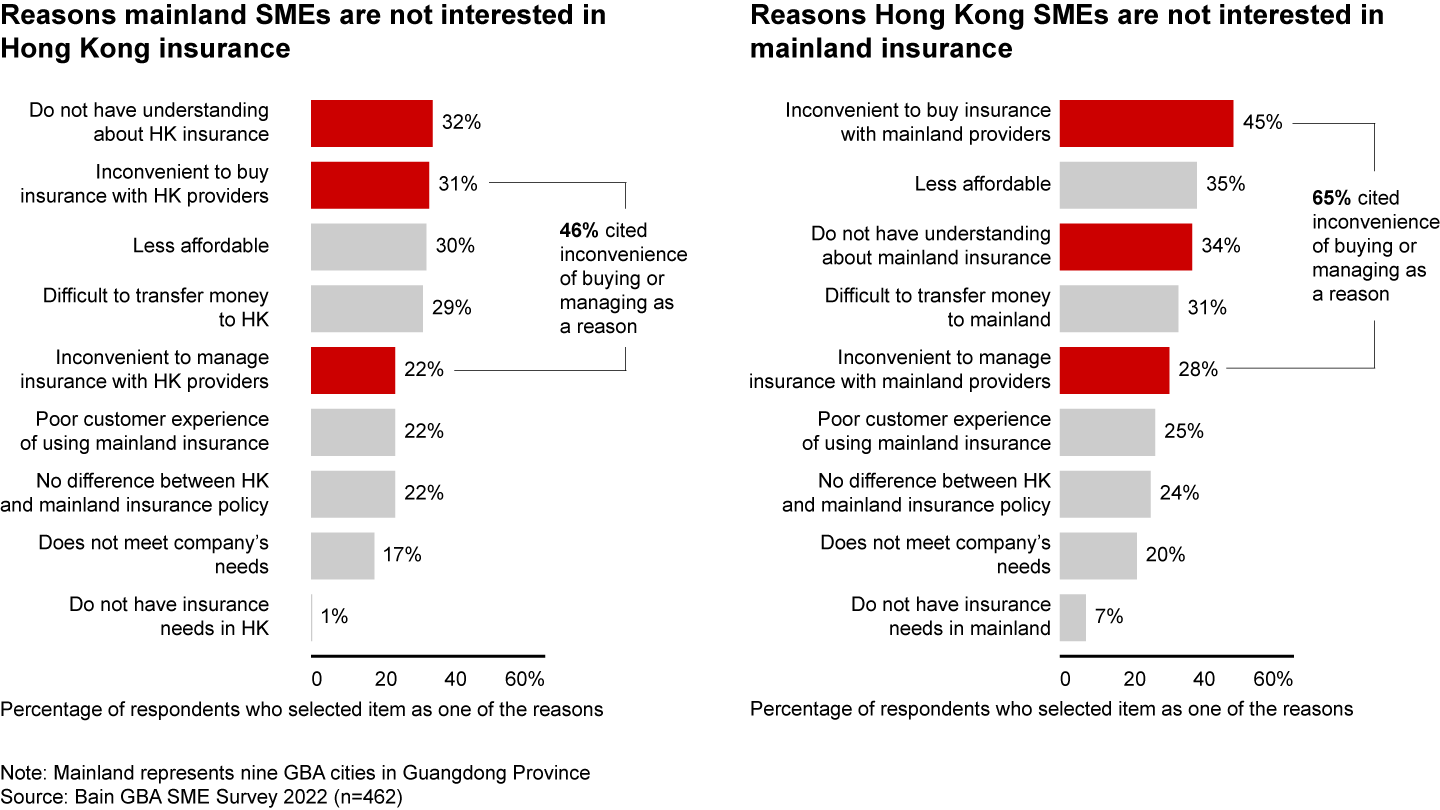
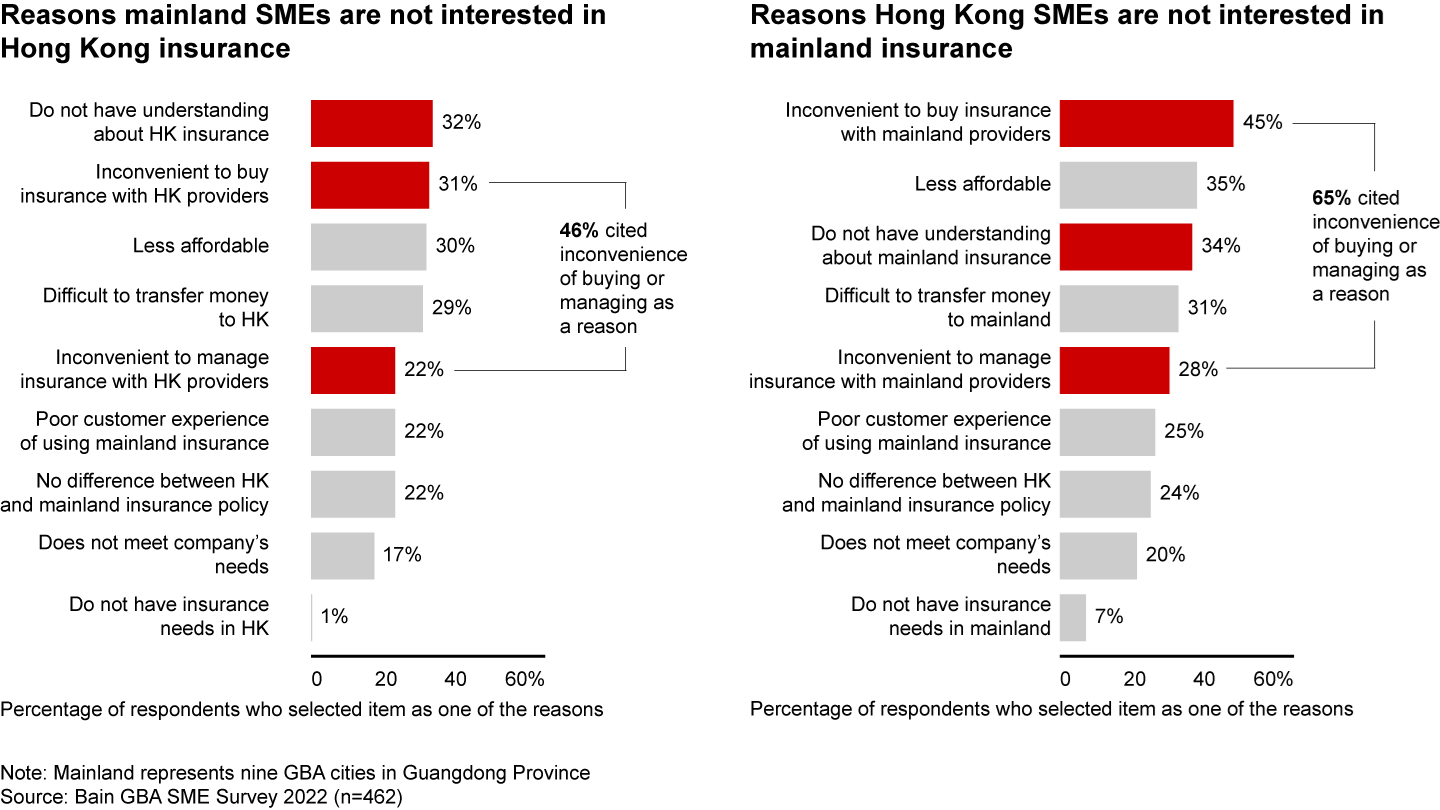
Digitization of cross-boundary financial services
Digital processes, like electronic signatures or application processing, can help overcome some of these obstacles. Increased digitization would release some friction from the process—and address rising consumer preferences. About half of the SMEs in mainland China and Hong Kong say they prefer to buy and manage cross-boundary financial products through a digital channel.
That’s not to say financial providers can become digital-only organizations. Preference for digital and in-person channels is split nearly 50-50 (see Figure 11)—and digital ranks about 10 percentage points lower for foreign purchasing than it does for domestic transactions.
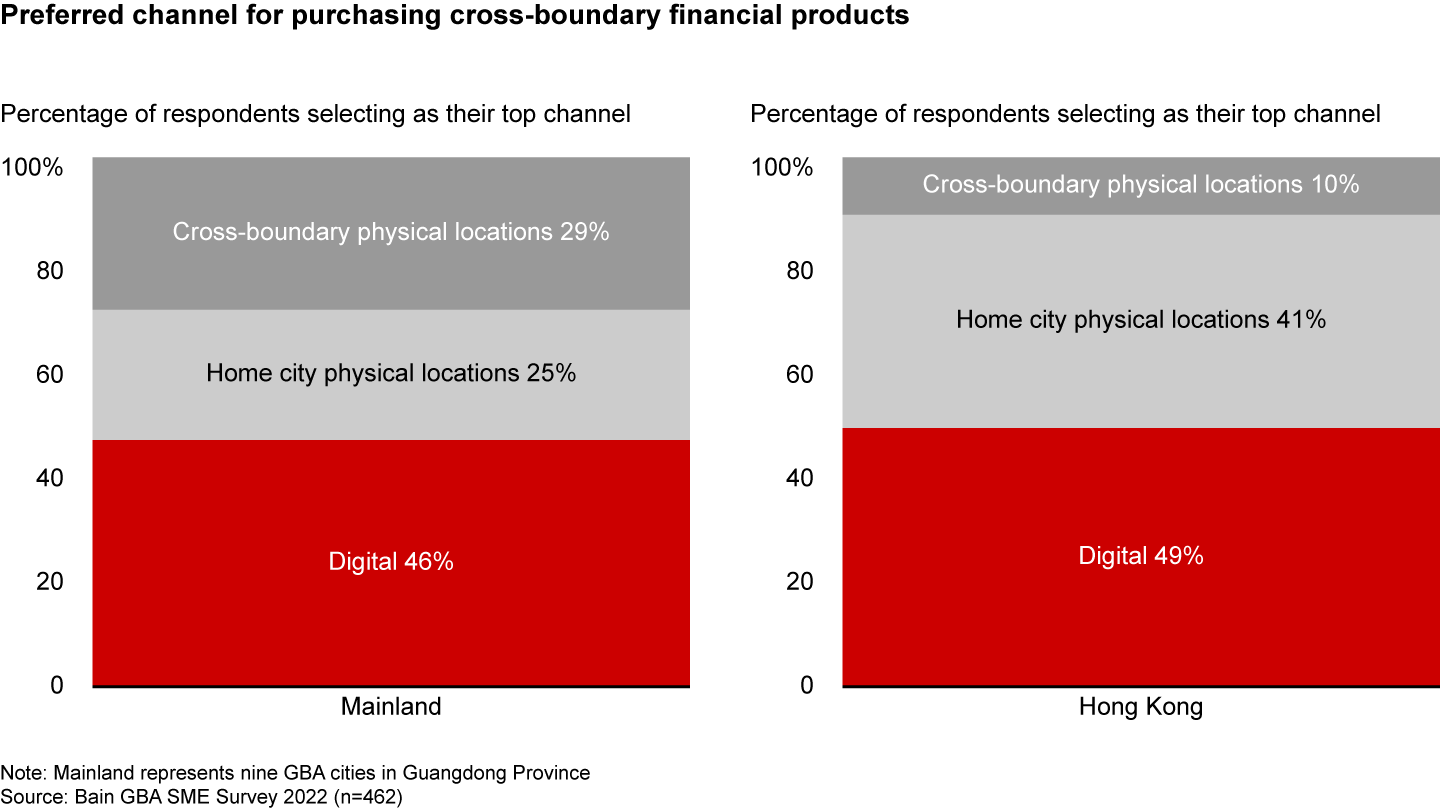
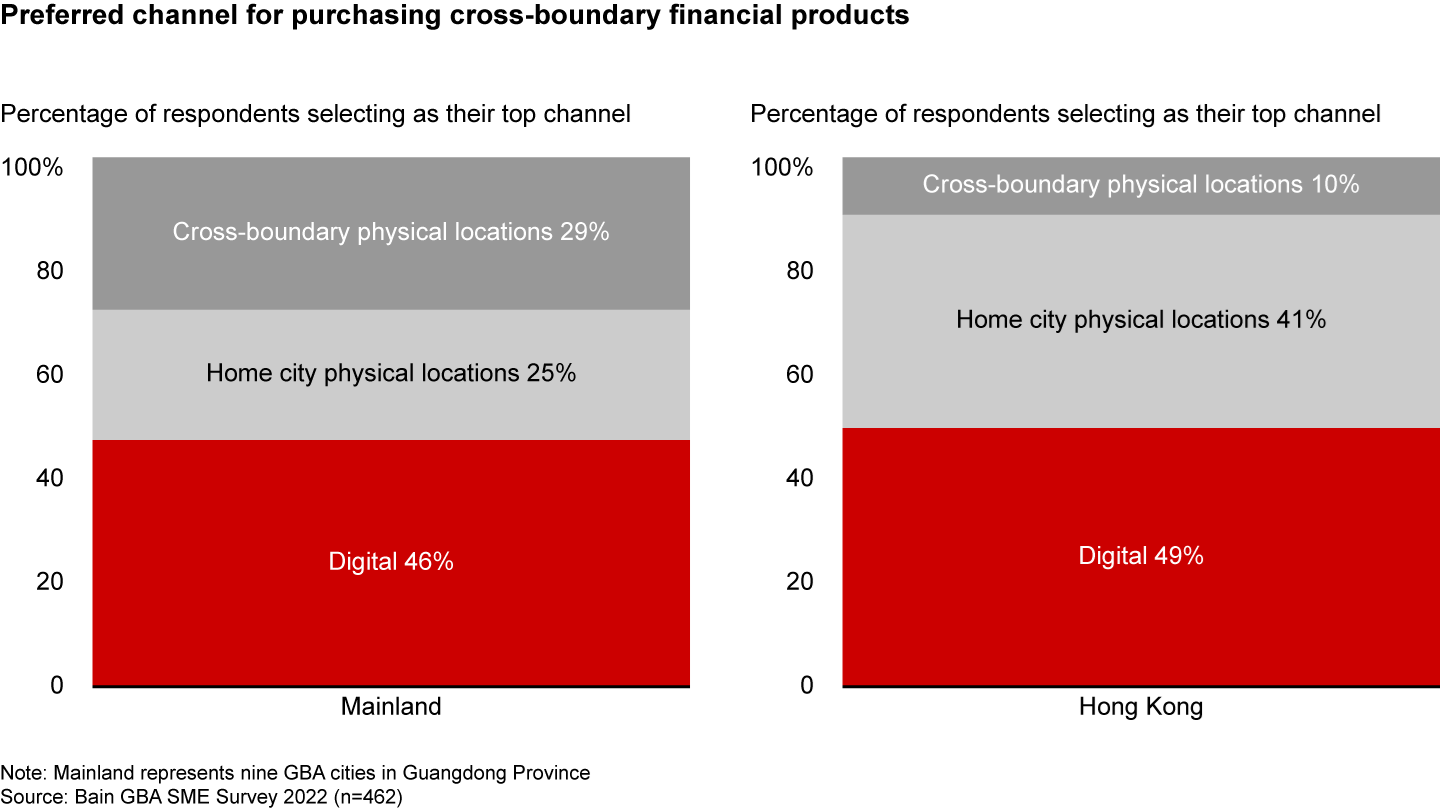
Since cross-boundary products and processes are typically more complicated, SMEs need more support and will feel more comfortable working with a representative to handle these transactions. Physical locations and human interaction will be important tools for delivering complex services. But financial institutions will need to fully support multiple channels—and tightly interconnect them—to deliver seamless, superior customer experiences.
Digital transformations should create strong links between online and offline channels and between geographically dispersed teams. “Staff in every region need to be able to share information and collaborate, subject to regulatory consent on cross-border information sharing. They should be familiar with each other and able to easily refer to one another to deliver a seamless experience for customers,” according to Donald Lam, head of commercial banking at Hang Seng Bank.
Technologies like blockchain can support cross-boundary endeavors. For trade finance, Hong Kong SMEs already use eTradeConnect, a blockchain-based platform initiated by the Hong Kong Monetary Authority and several major banks. Connectivity between eTradeConnect and the Chinese Central Bank’s Trade Finance Blockchain Platform makes cross-boundary trade financing more streamlined, secure, and cost-efficient for SMEs.
Opportunities for financial institutions to expand in the GBA
The GBA has excellent development opportunities, backed by solid infrastructure and strong regulatory support. Once borders reopen, SMEs have high expectations—and potential—for long-term economic growth. Financial services providers can step in and solve unmet financial services needs to accelerate their progress.
While there’s no one-size-fits-all approach, financial institutions that want to grow their business across boundaries in the GBA must answer three questions (see Figure 12). They must determine: What’s their long-term vision for the GBA? Where should they play? How can they win?
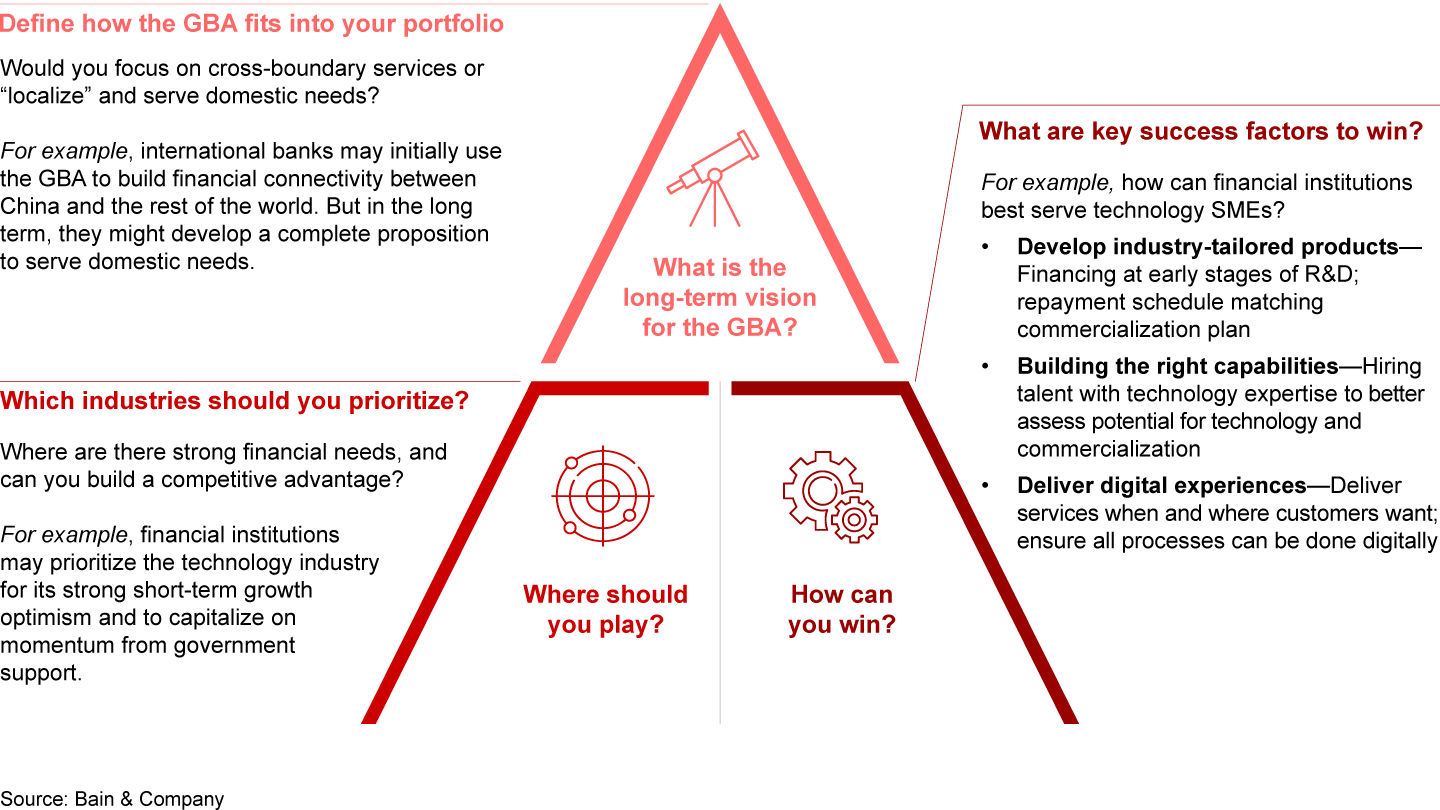
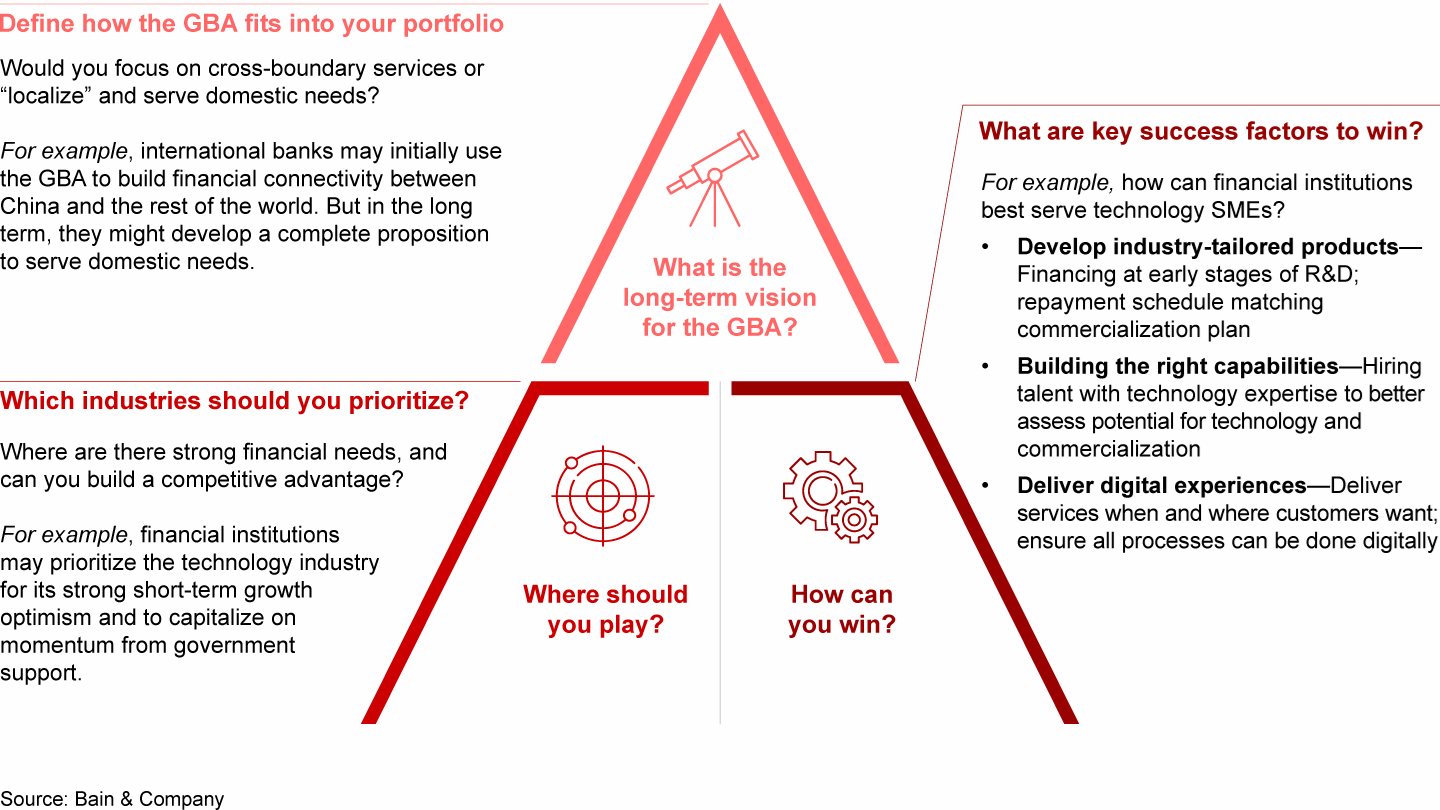
First, financial institutions need to clearly define how the GBA will factor into their future portfolios. Cross-boundary plans can be niche by design, or financial institutions can enter into full-scale competition against domestic providers. For example, GBA banks with existing international networks could start by building financial connectivity between China and the rest of the world, especially through supply chain or accounts receivables financing. Then they can consider whether to invest in the region further. They could expand their value proposition to include more products or widen their distribution network to serve domestic needs across boundaries.
Then, financial institutions should determine where to play, evaluating industries in the GBA based on their potential financial services needs—and the institution’s ability to serve them.
For example, the technology industry is an attractive potential target. Based on our survey, short-term optimism is higher among technology firms than for SMEs overall. And the government is providing significant tailwind via investment funding and supportive human capital policies.
Pain points are different in every industry though, so financial institutions need to do their homework. They need to understand their target industry’s unique challenges and preferences to build attractive offerings and win business.
For example, technology SMEs often need loan products with low collateral requirements and longer repayment schedules. Technology SMEs told us they have more funding needs during development but struggle to secure loans because they lack collateral assets at that stage. They also say it takes a long time to commercialize innovations, so they prefer longer loan repayment schedules.
Financial institutions that want to serve technology companies need deep technical knowledge to properly issue credit assessments. Direct knowledge and experience in the industry is necessary to understand how products are being developed, their potential for commercialization, and any associated risk. Without these skills, financial institutions won’t be able to tailor products or satisfy the financial institution’s risk controls.
Technology companies also have a strong preference for digitally enabled purchasing and servicing. “Comprehensive digital services” is a top-five purchasing criteria for 41% of Hong Kong technology SMEs but only 26% of SMEs in other industries. To compete for business in the technology industry, financial institutions must deliver end-to-end digital experiences.
To serve technology companies, financial institutions need to develop industry-tailored products, expand their technical knowledge, and enable digital processes. That’s how they will win.
Regardless of the industry they pursue, financial institutions must develop a nuanced understanding of foreign consumers. Teams from both regions will need to work well together and develop a close collaboration model.
To bridge any differences, financial institutions need to study the local culture. They can host regular meetings where colleagues share insights about customers in the region. Or they can facilitate worker exchange programs in which colleagues spend time in cross-boundary assignments.
Customer needs and expectations are nuanced, so institutions need to study the market carefully. A foreign approach won’t win local business. By giving voices from both sides equal opportunity to share their experiences, financial institutions can learn how to adapt products, services, terms, or channels to attract cross-border customers.
Opportunity awaits
About half of the mainland SMEs say they’re likely to expand into Hong Kong or Macau, and nearly 75% of Hong Kong SMEs expect to expand into mainland China. SMEs are ready to grow when borders reopen—but they need help. They believe financial services providers are best positioned to answer the call.
To expand, SMEs say they need convenient lending, professional wealth management services, flexible insurance policies, and comprehensive cash and liquidity management.
SMEs make, support, and deliver the products and services that will transform the GBA into a global technology, innovation, and e-commerce hub. Improved cross-boundary financial services will allow everyone—SMEs, large corporations, and unicorns—to move faster and at a larger scale.
The GBA presents an enormous opportunity for financial services providers that can innovate beyond traditional services.
In the GBA, SMEs have substantial, underserved financial services needs (and likely more that are still unrecognized). By serving the GBA as it grows, financial services providers can reach untapped segments and create a gateway strategy for more open financial systems.

About Hang Seng Bank
Hang Seng Bank is celebrating its 90th anniversary this year. Founded in 1933, Hang Seng Bank has continually innovated to provide best-in-class, customer-centric banking, investment, and wealth management services for individuals and businesses. It is widely recognized as the leading domestic bank in Hong Kong, currently serving more than 3.5 million customers. Combining its award-winning mobile app and strong digital capabilities with a vast network of over 260 service outlets in Hong Kong, Hang Seng offers a seamless omni-channel experience for customers to take care of their banking and financial needs anytime, anywhere. Its wholly owned subsidiary, Hang Seng Bank (China) Limited, operates a strategic network of outlets in almost 20 major cities in Mainland China to serve a growing base of Mainland customers locally and those with cross-boundary banking needs. The Bank also operates branches in Macau and Singapore, and a representative office in Taipei. As a homegrown financial institution, Hang Seng is closely tied to the Hong Kong community. It supports the community with a dedicated program of social and environmental initiatives focused on future skills for the younger generation, sustainable finance and financial literacy, addressing climate change, and caring for the community. Hang Seng is a principal member of the HSBC Group, one of the world’s largest banking and financial services organizations.